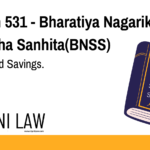Code: Section 143 BSA
(1) Witnesses shall be first examined-in-chief, then (if the adverse party so
desires) cross-examined, then (if the party calling him so desires) re-examined.
(2) The examination-in-chief and cross-examination must relate to relevant facts, but
the cross-examination need not be confined to the facts to which the witness testified on
his examination-in-chief.
(3) The re-examination shall be directed to the explanation of matters referred to in
cross-examination; and, if new matter is, by permission of the Court, introduced in
re-examination, the adverse party may further cross-examine upon that matter.
Explanation of Section 143 BSA
Section 143 of the Bharatiya Sakshya Adhiniyam outlines the proper sequence and scope of examining a witness during a trial. It ensures a structured and fair approach to witness testimony and cross-examination.
Key Components:
- Examination-in-Chief: The initial questioning of a witness by the party who calls them. This must be focused on relevant facts.
- Cross-Examination: Conducted by the opposing party. It can include both facts discussed during the chief examination and other relevant areas.
- Re-Examination: Limited to clarifying matters brought up during cross-examination. If new information arises, the adverse party is allowed to cross-examine again on those points.
This provision maintains the integrity of the witness examination process and ensures both parties have equal opportunities to question and clarify testimonies.
Illustration
Example 1: Standard Order of Examination
A prosecution witness is first questioned by the public prosecutor (examination-in-chief). The defense lawyer then cross-examines the witness on contradictions. Finally, the public prosecutor re-examines the witness to clarify the inconsistencies raised in cross-examination.
Example 2: Introduction of New Matter in Re-Examination
During re-examination, the prosecution introduces new documents. With the Court’s permission, the defense is then allowed to cross-examine the witness again to question them on those documents.
Common Questions and Answers on Section 143 BSA
1. Why is the order of examination important in a trial?
It ensures procedural fairness. Both parties get a structured opportunity to present and challenge evidence, preventing surprise or one-sided questioning.
2. Can cross-examination go beyond what was asked in the examination-in-chief?
Yes. According to subsection (2), cross-examination is not limited to just the facts covered during the chief examination; it can explore any relevant facts.
3. What happens if new matters are brought up during re-examination?
If the Court permits, the opposing party can conduct a further cross-examination specifically on the new matters introduced.
4. Is re-examination mandatory?
No, it’s optional and only carried out if the party who called the witness feels there’s a need to clarify issues raised during cross-examination.
Conclusion
Section 143 of the Bharatiya Sakshya Adhiniyam ensures fairness in the trial process by defining the structured order of witness examinations. By allowing both parties equal opportunity to examine, cross-examine, and re-examine witnesses, the provision protects the principles of natural justice and procedural transparency.
For more expert analysis of legal provisions, visit ApniLaw.








